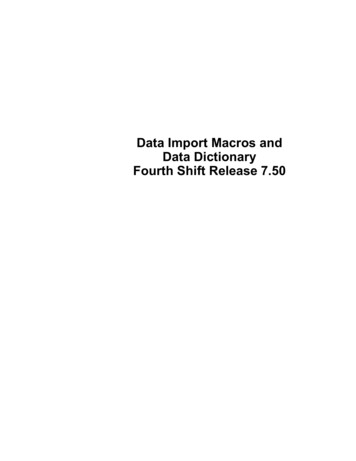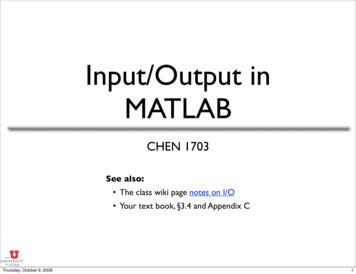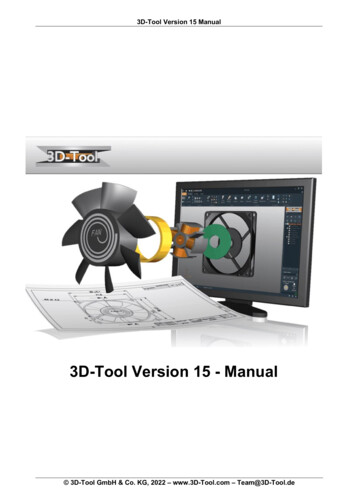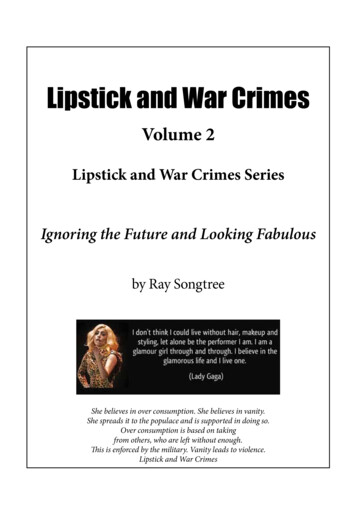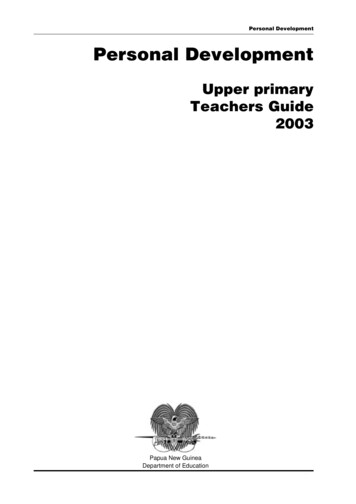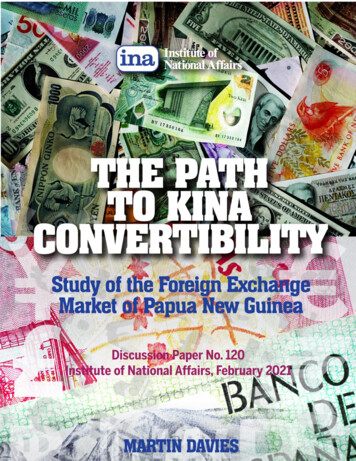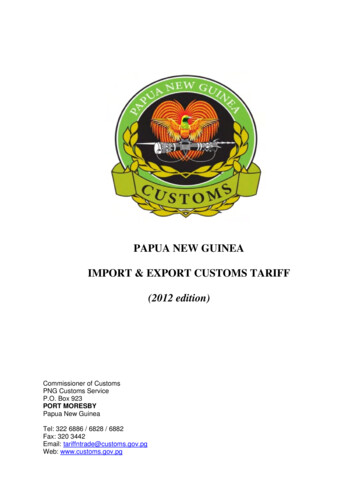
Transcription
PAPUA NEW GUINEAIMPORT & EXPORT CUSTOMS TARIFF(2012 edition)Commissioner of CustomsPNG Customs ServiceP.O. Box 923PORT MORESBYPapua New GuineaTel: 322 6886 / 6828 / 6882Fax: 320 3442Email: tariffntrade@customs.gov.pgWeb: www.customs.gov.pg
INDEPENDENT STATE OF PAPUA NEW GUINEANo 26of1992AN ACTENTITLEDCUSTOMS TARIFF ACT 1990,Being an Act relating to duties of Customs, to be incorporated and read as one with the Customs Act (Chapter 101).MADE by the National Parliament to come into operation on 1st January 2012.PART 1.1.INTERPRETATION.In this Act, unless the contrary intention appears " Chapter" means a Chapter of a Section of Schedule 1;" Column" means a column of a Schedule;" dash" represents the symbol "-";"gas project" means the gas project as defined in Clause 1. of the Gas Agreement between the State,the Bank of Papua New Guinea and the Project Developers signed in Port Moresby on the 6thof June 2002;"gas project imports" means imports by any of the companies defined as Gas Project Companies inClause 1. of the Gas Agreement, or imports for the gas project pursuant to a writtenagreement between a Gas Project Company and a person engaged by a Gas Project Companyfor the purpose of importing or supplying goods to the project;" heading" means a heading in Schedule in four or five digits;" Interpretation Rules" means the general rules for the determination of Import Tariff Classification asspecified in Section 8;" Plantation Logs" means logs derived from forest plantations established artificially, either byafforestation on land which has not carried forest within living memory or by reforestation ofland which carried forest before but where the indigenous species are replaced with a newspecies or genetic variety. Enrichment planting and other such silvicultural treatments ofnatural forests following selective logging do not qualify as forest plantations." presented", in relation to goods, means imported into Papua New Guinea;" subject to variation on export price change" means subject to adjustment by the Minister underSection 5 (3);" Tariff Item" means eight digits in column 1;" this Act" includes the Regulations.PART II.2.- PRELIMINARY.- DUTIES OF CUSTOMS.DUTIES OF CUSTOMS ON IMPORTS.(1)Subject to Subsection (2) and to this Act, duties of Customs, being import duties, are imposed, inaccordance with this Part, on all goods imported into Papua New Guinea whether imported before, onor after the date of coming into operation of this Act and shall be charged, collected and paidaccordingly.(2)Subsection (1) does not apply to goods imported into Papua New Guinea before the date of coming intooperations of this Act, unless they are entered for home consumption on or after the date of coming intooperation of the Act.(3)Where for any reason, goods are entered for home consumption more than once, and the goods werefirst entered for home consumption before the date of coming into operation of this Act:
(a)(b)3.the provisions of Section 79 of the Customs Act (Chapter 101) are deemed to refer to the firstentry for home consumption; andthe duty imposed on the goods by this Section is the duty that would have been applicable ifthis Act had not been enacted.RATE OF IMPORT DUTY.(1)Subject to Subsection (3) the import duty in respect of imported goods is the rate of duty specifiedunder the heading " Rate of Duty" in column 3 of Schedule 1 opposite the Tariff Item number anddescription of the goods.(2)Where the rate of import duty in column 3 of Schedule 1 is specified as "Free" opposite the descriptionof goods, the rate of import duty on those goods is free.(3)Notwithstanding anything else in this Act, for(a) gas project imports of any prefabricated production or processing equipment used or requiredsolely or substantially in or for the Gas project, including in particular such items falling undertariff items set out in the table below, the rate of import duty applicable from 1st January 2002 shallbe ‘free’Tariff ItemDescription of Goods6810.91.00Prefabricated structural components for building or civil engineering7301.2Angles, shapes and sections7308.10.00Bridges and bridge sections7308.90.90Other (structures)7309.00.00Reservoirs, tanks, vats and similar containers for any material (other thancompressed or liquefied gas), of iron or steel, of a capacity exceeding 300L,whether or not lined or heat insulated, but not fitted with mechanical orthermal equipment.; and(b) all other Gas Project imports the rate of import duty applicable from 1st January 2002 shall be therate shown under the heading “Duty Rate On and From 1st Jan 2006”.”4.DUTIES OF CUSTOMS ON EXPORTS.Subject to the provisions of this Act, duties of Customs, being export duties, are imposed in accordance with thisPart on all goods exported from Papua New Guinea and shall be charged, collected and paid on all such goodsaccordingly.5.RATE OF EXPORT DUTY.(1)The export duty in respect of goods entered for export out of Papua New Guinea is the rate of dutyspecified in Column 3 (headed "Rate") of Schedule 2 opposite the Tariff Item number and descriptionof the goods.(2)Where no item in Schedule 2 applies to goods entered for export the rate of duty is free.(3)Where, in column 4 of Schedule 2, the rate of duty in respect of goods is marked "subject to variationon export price change", the Minister may adjust the rate of duty in respect of those goods by apercentage equal to the percentage of any change in the export price of such goods, provided that suchadjustment in the rate of duty amounts to a change of at least K0.01 per taxable unit.6.PERCENTAGE RATE ON DUTY.(1)Where reference is made to a percentage in relation to a rate of duty, the reference shall be read as areference to that percentage of the value of the goods.(2)For the purpose of this Act, the value of any imported goods is the value for duty of the goodsdetermined in accordance with Section 95 (1) of the Customs Act (Chapter 101).7.EXPORT VALUE.(1)For the purpose of Schedule 2, the rate of export duty, in relation to goods entered for export out ofPapua New Guinea, shall be determined according to the export value at the level of free on board(f.o.b.) which represents a satisfactory return for the exported goods that is, in all circumstances, thetotal price paid or payable by the buyer who intends to take delivery in the importing country.(2)For the purpose of this Act, the Minister may, by notice in the National Gazette, declare a value perunit of goods to be the value which shall be used for the purpose of calculating the export value of thegoods subject to export duty under this Act.
PART III.8.- DETERMINATION OF TARIFF CLASSIFICATION.DETERMINATION OF TARIFF CLASSIFICATION.(1)(2)Goods are classified for the purpose of this Act in accordance with the Tariff Classification in Schedule1.The titles of Sections and Chapters incorporated in Schedule 1 are provided for ease of reference onlyand for all other purposes classification shall be determined according to the terms of headings and anyrelative Section and Chapter Notes and, provided further that such terms of headings or Notes do nototherwise require, according to the following rules:(a)a reference in a term of heading to any goods shall be taken to include a reference to thosegoods incomplete or unfinished, provided that, as imported, the incomplete or unfinishedgoods have the essential character of the complete or finished goods, and shall also be taken toinclude a reference to those goods complete or finished or falling to be classified as completeor finished by virtue of this provision), imported unassembled or disassembled;(b)a reference in a heading to a material or substance shall be taken to include a reference tomixtures or combinations of that material or substance with other materials or substances anda reference to goods of a given material or substance shall be taken to include a reference togoods consisting wholly or partly of such material or substance;(c)the classification of goods consisting of more than one material or substance shall beaccording to the provision contained in Paragraph (d);(d)where, for any reason, goods are, prima facie, classifiable under two or more headings,classifications shall be effected as follows:(i)the heading which provides the most specific description shall be referred to otherheadings providing a more general description, but, where two or more headings eachrefer to part only of the materials or substances contained in mixed or compositegoods or to part only of the goods in a set put up for retail sale, those heading are tobe regarded as equally specific in relation to those goods, even if one of them gives amore complete or precise description of the goods;(ii)mixtures, composite goods consisting of different materials or made up of differentcomponents, and goods put in sets for retail sale, which cannot be classified byreference to Subparagraph (i), shall be classified as if they consisted of the materialor component which gives them their essential character, in so far as this criterion isapplicable;(iii)when goods cannot be classified by reference to Subparagraphs (i) or (ii), they shallbe classified under the heading which occurs last in numerical order among thosewhich equally merit consideration;(e)goods which cannot be classified in accordance with Paragraphs (a) to (d) inclusive shall beclassified under the heading appropriate to the goods to which they are most akin;(f)in addition to the provisions specified in Paragraphs (a) to (e) inclusive, the followingprovisions shall apply in respect of the goods referred to therein:(i)camera cases, musical instrument cases, gun cases, drawing instrument cases,necklace cases and similar containers made of any material or substance (other thanthose made of precious metal, gold or silver or studded with pearls, diamonds or anyother precious stones), specially shaped or fitted to contain a specific set of goods,suitable for long-term use and imported in equal quantity with the goods for whichthey are intended, shall be classified with such goods when of a kind normally soldtherewith, but this criterion does not apply to containers which give the whole itsessential character; and;(ii)subject to the provisions of Subparagraph (i), packing materials and packingcontainers imported with the goods therein shall be classified with the goods if theyare of a kind normally used for packing such goods, but this provision does not applywhen such packing materials or packing containers are clearly suitable for repetitiveuse, and the containers which are used by shipping companies for the carriage ofcargo in accordance with the "CONTAINERS CONVENTION" shall not beconsidered as part of the goods;(g)the classification of imported goods referred to in the subheadings shall be determinedaccording to the terms of those subheadings and any related Section or Chapter Notes and,mutatis-mutandis, to the above provisions, on the understanding that only subheadings at thesame level are comparable and for the purposes of this Subsection the relative Section andChapter Notes also apply, unless the context otherwise requires.
PART IV.- EXEMPTION FROM AND REDUCTION OF IMPORT OF DUTY9.EXEMPTION FROM AND REDUCTION OF IMPORT DUTY(1)The Head of State, acting on advice, may by notice in the National Gazette(a)exempt from import duty any goods other than goods imported in relation to a commercialproject otherwise subject to import duty under this Act; or(b)substitute a reduced rate of import duty in respect of any goods subject to import duty underthis Act for that specified in Schedule 1 in respect of those goods.(2)An exemption from or a reduced rate of import duty under Subsection (1) (a)may relate to (i) any class of goods; or(ii) any goods or class of goods imported for a purpose specified in the notice; and(b)may further be subject to compliance with any conditions as are specified in the notice; and(c)shall continue in force for such period as is specified in the notice or until the revocation ofsuch notice by a subsequent notice.(3)For the purpose of Subsection (1) (a) “commercial project” means a project intended to be operated soas to make a profit.9AEXEMPTION FOR RAMU NICKEL PROJECT.(1) In this Section –“Mining Development Contract – Ramu Nickel Project” means the Mining DevelopmentContract – Ramu Nickel Project that was signed on 26 July 2000 by the Independent State ofPapua New Guinea, Ramu Nickel Limited and Orogen Minerals (Ramu) Limited as amendedby the Mining Development Contract Amendment Agreement Ramu Nickel Project that wassigned on 10 August 2006 by the Independent State of Papua New Guinea, MCC Ramu NiCoLtd, Ramu Nickel Limited, Mineral Resources Ramu Limited and Mineral Resources MadangLimited.“commencement of the tax holiday”, “consumables”, “contractor” “joint venturer”, “manager”, and“project” have the same meanings respectively as in the Mining Development Contract –Ramu Nickel Project;“Schedule II” means Schedule II of the Mining Development Contract – Ramu Nickel Project;“Schedule III” means Schedule III of the Mining Development Contract – Ramu Nickel Project;(2) Subject to subsections (3) and (4), the following goods are exempt from customs duty:(a) for the life of the project, all hydrocarbons products to be used or consumed as fuel for theproject’s powerhouse including without limitation, heavy oils, bunker C oils, furnace oils anddiesel; and(b) all goods and consumables to be used or consumed for or by the project and which are imported byor on behalf of the joint venturers or any of them or by the manager prior to the fifth anniversary ofthe commencement of the tax holiday.(3) This section does not apply in respect of goods and consumables specified in Schedule II.(4) The exemption under subsection (1) applies and extends to goods and consumables to be used or consumedfor the project which are imported by the manager or by any contractor provided that the requirements ofSchedule III are first satisfied whenever the benefit of the provision is claimed.”9BEXEMPTION FOR PNG LNG GAS PROJECT.(1) In this Section –“Affiliate” has the meaning given in the PNG LNG Gas Agreement;“LNG Project” has the meaning given in the PNG LNG Gas Agreement;“LNG Project Company” has the meaning given in the PNG LNG Gas Agreement;“LNG Project Petroleum” has the meaning given in the PNG LNG Gas Agreement;“PNG LNG Gas Agreement” means the PNG LNG Gas Agreement dated 22 May 2008 betweenIndependent State of Papua New Guinea and each of Esso Highlands Limited, Esso PNG JuhaLimited, Ampolex (Papua New Guinea) Limited, Ampolex (PNG Petroleum), Inc.,Ampolex (Highlands) Limited, Oil Search Limited, Oil Search (PNG) Limited, Oil Search(Tumbudu) Limited, Merlin Petroleum Company, Merlin Pacific Oil Company Limited,Santos Hides Ltd, Lavana Limited, AGL Gas Developments (PNG) Pty Limited, PetroleumResources Kutubu Limited, Petroleum Resources Gobe Limited and Eda Oil Limited, asamended, novated or replaced from time to time;
“LNG Project Goods and Consumables” means goods and consumables:(a) that are imported into Papua New Guinea for or by the PNG LNG Companies to be solelyused or consumed by the LNG Project in connection with the initial construction of theLNG Project, provided that the goods and consumables are specifically for theconstruction of or preparation of gas operations as defined in the Income Tax Act 1959except for goods and consumables that are in the nature of prohibited imports andprohibited exports as defined under the Customs(Prohibited Imports) Regulation(Chapter 101) and Customs (Prohibited Exports) Regulation (Chapter 101); or(b) that are imported into Papua New Guinea for or by the PNG LNG Companies to be solelyused or consumed by the LNG Project in any subsequent phase of the LNG Project wherethe total project costs exceeds USD50 million (or equivalent) as provided in the PNGLNG Gas Agreement, provided that the goods and consumables are specifically for theconstruction of or preparation of gas operations as defined in the Income Tax Act exceptgoods and consumables that are in the nature of prohibited imports and prohibited exportsas defined under the Customs (Prohibited Imports) Regulation (Chapter 101) andCustoms (Prohibited Exports) Regulation (Chapter101).(2) Not withstanding any other provision of this Act, no bond, rate, tax, excise, rent, charge, due, fee, duty,withholding, tariff, or other levy or impost shall be applied or payable in respect of the export of LNGProject Petroleum by an LNG Project Company or any customer of an LNG Project Company.(3) Not withstanding any other provision of the Act, no bond, rate, tax, excise, rent, charge, due, fee, duty,withholding, tariff, or other levy or impost shall be applied or payable under this Act by the LNG ProjectCompanies or any of their Affiliates or any person engaged by an LNG Project Company pursuant to awritten agreement on the import, export, use or movement of LNG Project Goods and Consumables to beused or consumed for or by the LNG Project in connection with:(a) the initial construction; or(b) any subsequent phase or the project whose total cost exceeds USD 50 million orequivalent.PART V - PROHIBITED IMPORTS AND EXPORTS.11.PROHIBITED IMPORTS.Subject to the provisions contained in the Customs (Prohibited Imports) Regulation, where import duty payableunder Section 2 has not been paid on any goods, these goods are prohibited imports within the meaning of theCustoms Act (Chapter 101).12.PROHIBITED EXPORTS.Subject to the provisions contained in the Customs (Prohibited Exports) Regulation, Export (DesiccatedCoconut Regulation), Export (Fish) Regulation and the Exports (Control and Valuation) Act (Chapter 108),where export duty payable under Section 4 has not been paid on any goods, those goods are a prohibited exportwithin the meaning of the Customs Act (Chapter 101).PART VI.- REPEAL AND SAVING.13.REPEAL.The Acts specified in Schedule 3 are repealed.14.SAVING.(1)In this section, "the repealed Act" means the Acts specified in Schedule 3.(2)All import and export duties of Customs chargeable, collectable and payable under the repealed Actswhich, at the date of coming into operation of this Act, had not been charged, collected, and paid, shall,notwithstanding the coming into operation of this Act, in so far as not charged, collected and paidcontinue to be chargeable, collectable, and payable.PART VII.15.- MISCELLANEOUS.REGULATIONS.The Head of State, acting on advice, may make Regulations not inconsistent with this Act, prescribing allmatters that are required or permitted to be prescribed or that are necessary or convenient to be prescribed forcarrying out or giving effect to this Act, and in particular for prescribing penalties of fines not exceeding K1,000.00 for offences in violation of the regulations.
GENERAL RULES FOR THE INTERPRETATION OF THE HARMONIZED SYSTEM1.The title of Sections, Chapters and sub-Chapters are provided for ease of reference only; for legalpurposes, classification shall be determined according to the terms of the headings and any relativeSection or Chapter Notes and, provided such headings or Notes do not otherwise require, accordingto the following provisions:2.(a)Any reference in a heading to an article shall be taken to include a reference to that articleincomplete or unfinished, provided that, as presented, the incomplete or unfinished articlehas the essential character of the complete or finished article. It shall also be taken toinclude a reference to that article complete or finished (or falling to be classified as completeor finished by virtue of this Rule), presented unassembled or disassembled.(b)Any reference in a heading to a material or substance shall be taken to include a referenceto mixtures or combinations of that material or substance with other materials or substances.Any reference to goods of a given material or substance shall be taken to include a referenceto goods consisting wholly or partly of such material or substance. The classification ofgoods consisting of more than one material or substance shall be according to the principlesof Rule 3.3.When by application of Rule 2 (b) or for any other reason, goods are, prima facie, classifiable undertwo or more headings, classification shall be effected as follows :(a)The heading, which provides the most specific description, shall be preferred to headingsproviding a more general description. However, when two or more headings each refer topart only of the materials or substances contained in mixed or composite goods or to partonly of the items in a set put up for retail sale, those headings are to be regarded as equallyspecific in relation to those goods, even if one of them gives a more complete or precisedescription of the goods.(b)Mixtures, composite goods consisting of different materials or made up of differentcomponents, and goods put up in sets for retail sale, which cannot be classified byreference to 3 (a), shall be classified as if they consisted of the material or componentwhich gives them their essential character, insofar as this criterion is applicable.(c)When goods cannot be classified by reference to 3 (a) or 3 (b), they shall be classifiedunder the heading which occurs last in numerical order among those which equally meritconsideration.4.Goods which cannot be classified in accordance with the above Rules shall be classified under theheading appropriate to the goods to which they are most akin.5.In addition to the foregoing provisions, the following Rules shall apply in respect of the goods referredto therein :6.(a)Camera cases, musical instrument cases, gun cases, drawing instrument cases, necklacecases and similar containers, specially shaped or fitted to contain a specific article or set ofarticles, suitable for long-term use and presented with the articles for which they areintended, shall be classified with such articles when of a kind normally sold therewith.The Rule does not, however, apply to containers, which give the whole its essential character.(b)Subject to the provisions of Rule 5 (a) above, packing materials and packing containerspresented with the goods therein shall be classified with the goods if they are of a kindnormally used for packing such goods. However, this provision does not apply when suchpacking materials or packing containers are clearly suitable for repetitive use.For legal purposes, the classification of goods in the subheadings of a heading shall be determinedaccording to the terms of those subheadings and any related Subheading Notes and,mutatis mutandis, to the above Rules, on the understanding that only subheadings at the samelevel are comparable. For the purposes of the Rule the relative Section and Chapter Notes alsoapply, unless the context otherwise requires.
ABBREVIATIONS AND SYMBOLSACASTM kVarkWl or lt.mmm2 or Sq.mm3mgmjmmmNMPaNNo.opP&RprQrtUVVvol.vol. of alc.%x alternating currentAmerican Society for Testing Materialsdegree (s) CelsiusCylinder Capacitycentigram (s)centimetre (s)square centimetre (s)cubic centimetre (s)centinewton (s)caratdirect currentgram (s)gross vehicle weighthertzinfra-redkinakilocalorie (s)kilogram (s)kilogram forcekilonewton (s)kilopascal (s)kilovolt (s)kilovolt - ampere (s)kilovolt - ampere (s) - reactivekilowatt (s)litre (s)metre (s)metasquare metre (s)cubic metre (s)milligram (s)measuring joulemillimetre (s)millinewton (s)megapascal (s)newton (s)NumberorthoparaProhibitions and Restrictionspair (s)Quarantinetoeaultra-violetvolt (s)volumevolume of alcoholpercentx degree (s)EXAMPLES1500 g/m215 Cmeans one thousand five hundred gramsper square metremeans fifteen degrees Celsius
SEC. 3SCHEDULE ICUSTOMS TARIFFTABLE OF CONTENTSSECTION ILIVE ANIMALS; ANIMAL PRODUCTSSection Notes.Chapters1.2.3.4.5.Live animals.Meat and edible meat offal.Fish and crustaceans, molluscs and other aquatic invertebrates.Dairy produce; birds eggs; natural honey; edible products of animal origin, not elsewhere specified or included.Products of animal origin, not elsewhere specified or included.SECTION IIVEGETABLE PRODUCTSSection Note.6.7.8.9.10.11.12.13.14.Live trees and other plants; bulbs, roots and the like; cut flowers and ornamental foliage.Edible vegetables and certain roots and tubers.Edible fruit and nuts; peel of citrus fruit or melons.Coffee, tea, mate and spices.Cereals.Products of the milling industry; malt; starches; inulin; wheat gluten.Oil seeds and oleaginous fruits; industrial or medicinal plants; straw and fodder.Lac; gums; resins and other vegetable saps and extracts.Vegetable plaiting materials; vegetable products not elsewhere specified or included.SECTION IIIANIMAL OR VEGETABLE FATS AND OILS AND THEIRCLEAVAGE PRODUCTS; PREPARED EDIBLE FATS;ANIMAL OR VEGETABLE WAXES.15.Animal or vegetable fats and oils and their cleavage products; prepared edible fats; animal or vegetable waxes.SECTION IVPREPARED FOODSTUFFS;BEVERAGES, SPIRITS AND VINEGAR; TOBACCOAND MANUFACTURED TOBACCO SUBSTITUTESSection Notes.16.17.18.19.20.21.22.23.24.Preparations of meat, of fish or of crustaceans, molluscs or other aquatic invertebrates.Sugars and sugar confectionery.Cocoa and cocoa preparations.Preparations of cereals, flour, starch or milk; pastrycooks products.Preparations of vegetables, fruit, nuts or other parts of plants.Miscellaneous edible preparations.Beverages, spirits and vinegar.Residues and waste from the food industries; prepared animal fodder.Tobacco and manufactured tobacco substitutes.
10SECTION VMINERAL PROJECTS25.26.27.Salt; sulphur; earths and stone; plastering materials, lime and cement.Ores, slag and ash.Mineral fuels, mineral oils and products of their distillation; bituminous mineral waxes.SECTION VIPRODUCTS OF THE CHEMICAL OR ALLIED INDUSTRIESSection Notes.28.29.30.31.32.33.34.35.36.37.38.Inorganic chemicals; organic or inorganic compounds of precious metals, ofrare-earth metals of radioactive elements or of isotopes.Organic chemical.Pharmaceutical products.Fertilisers.Tanning or dyeing extracts; tannins and their derivatives; dyes, pigments and other colouring matters; paints andvarnishes; putty and other mastics; inks.Essential oils and resinoids; perfumery, cosmetic or toilet preparations.Soap, organic surface-active agents, washing preparations, lubricating preparations, artificial waxes, preparedwaxes, polishing or scouring preparations, candles and similar articles, modelling pastes; "dental waxes" anddental preparations with a basis of plaster.Albuminoidal substances; modified starches; glues; enzymes.Explosives; pyrotechnic products; matches; pyrophoric alloys; certain combustible preparations.Photographic or cinematographic goods.Miscellaneous chemical products.SECTION VIIPLASTICS AND ARTICLES THEREOF;RUBBER AND ARTICLES THEREOFSection Notes.39.40.Plastics and articles thereof.Rubber and articles thereof.SECTION VIIIRAW HIDES AND SKINS, LEATHER, FURSKINS ANDARTICLES THEREOF; SADDLERY AND HARNESS;TRAVEL GOODS HANDBAGS AND SIMILAR CONTAINERS;ARTICLES OF ANIMAL GUT (OTHER THAN SILK-WORM GUT)41.42.43.Raw hides and skins (other than furskins) and leather.Articles of leather; saddlery and harness; travel goods, handbags and similar containers; articles of animal gut(other than silk-worm gut).Furskins and artificial fur; manufactures thereof.Customs Tariff Act of 1990(Harmonized System 2012 Version)
11SECTION IXWOOD AND ARTICLES OF WOOD; WOOD CHARCOAL;CORK AND ARTICLES OF CORK; MANUFACTURES OF STRAW;OR ESPARTO OR OF OTHER PLAITING MATERIALS;BASKETWARE AND WICKERWORK44.45.46.Wood and articles of wood; wood charcoal.Cork and articles of cork.Manufactures of straw; of esparto or of other plaiting materials; basket ware and wickerwork.SECTION XPULP OF WOOD OR OF OTHER FIBROUS CELLULOSIC MATERIAL;“RECOVERED (WASTE AND SCRAP) PAPER OR PAPERBOARD”; PAPER ANDPAPERBOARD AND ARTICLES THEREOF47.48.49.Pulp of wood or of other fibrous cellulosic material; waste and scrap of paper or paperboard.Paper and paperboard; articles of paper pulp, of paper or of paperboard.Printed books, newspapers, pictures and other products of the printing industry; manuscripts, typescripts andplans.SECTION XITEXTILES AND TEXTILE ARTICLESSection lk.Wool, fine or coarse animal hair, horsehair yarn and woven fabric.Cotton.Other vegetable textile fibres; paper yarn and woven fabrics of paper yarn.Man-made filaments.Man-made staple fibres.Wadding, felt and nonwovens; special yarns; twine, cordage, ropes and cables and articles thereof.Carpets and other textile floor coverings.Special woven fabrics; tufted textile fabrics; lace tapestries; trimmings; embroidery.Impregnated, coated, covered or laminated textile fabrics; textile articles of a kind suitable for industrial use.Knitted or crocheted fabrics.Articles of apparel and clothing accessories knitted or crocheted.Articles of apparel and clothing accessories not knitted or crocheted.Other made up textile articles; sets; worn clothing and worn textile articles; rags.SECTION XIIFOOTWEAR, HEADGEAR, UMBRELLAS, SUN UMBRELLAS,WALKING-STICKS, SEAT-STICKS, WHIPS, RIDING-CROPS AND PARTSTHEREOF; PREPARED FEATHERS AND ARTICLES MADE THEREWITH;ARTIFICIAL FLOWERS; ARTICLES OF HUMAN HAIR64.65.66.67.Footwear, gaiters and the like; parts of such articlesHeadgear and parts thereof.Umbrellas, sun umbrellas, walking-sticks, seat-sticks, whips, riding-crops and parts thereof.Prepared feathers and down and articles made of feathers or of down; artificial flowers; articles of human hair.SECTION XIIIARTICLES OF STONE, PLASTER, CEMENT, ASBESTOS,MICA OR SIMILAR MATERIALS; CERAMIC PRODUCTS; GLASS AND GLASSWARE68.69.70.Articles of stone, plaster cement, asbestos, mica or similar materials.Ceramic products.Glass and glassware.Customs Tariff Act of 1990(Harmonized System 2012 Version)
12SECTION XIVNATURAL OR CULTURED PEARLS, PRECIOUS
INDEPENDENT STATE OF PAPUA NEW GUINEA No 26 of 1992 AN ACT ENTITLED CUSTOMS TARIFF ACT 1990, Being an Act relating to duties of Customs, to be incorporated and read as one with the Customs Act (Chapter 101). MADE by the National Parliament to come into operation on 1 st January 2012. PART 1.


